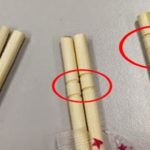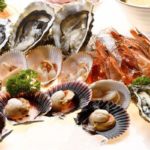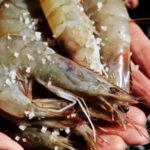Peeling live shrimp is easy, but because they don’t know how, many people lose all the meat. Here are some simple and easy ways to peel live shrimp.
In addition to peeling live shrimp, peeling cooked shrimp is probably not preferred by anyone because it takes a lot of time, especially if you are at a party and don’t want dirty hands, or the shrimp sauce splashes on your clothes and smells “unpleasant.” However, shrimp is delicious and nutritious, and if you don’t peel them, they are difficult to eat.
You should pocket these quick and clean ways to peel shrimp so that you can use them for banquets and parties and be praised for your skillful, elegant, and polite manners.
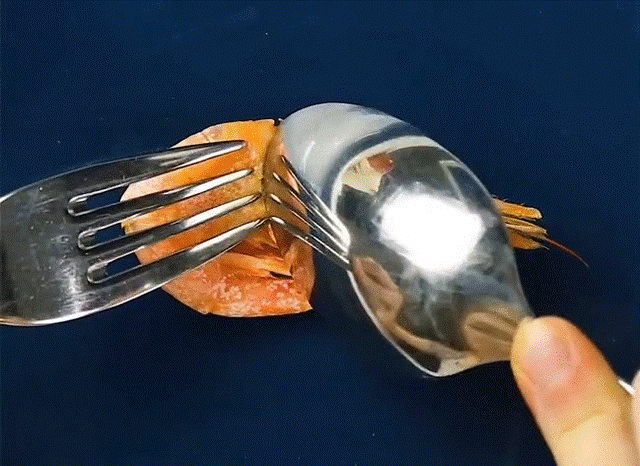
How to position the spoon and fork to peel shrimp. Illustrative image by 5 minute – crafts
Peel boiled shrimp when attending banquets and parties using a spoon and fork
You can’t use your hands to peel shrimp when attending parties, so use a fork and spoon to peel them. This way, you can enjoy the shrimp and be praised for your skillful, elegant, and polite manners. Using a spoon and fork to peel shrimp is convenient, doesn’t dirty your hands, and avoids the risk of shrimp sauce splashing on your clothes when participating in large, fancy parties.
First, position the fork and spoon between the head and body of the shrimp. Use the fork to secure the shrimp.
Use the spoon to remove the shrimp’s head.
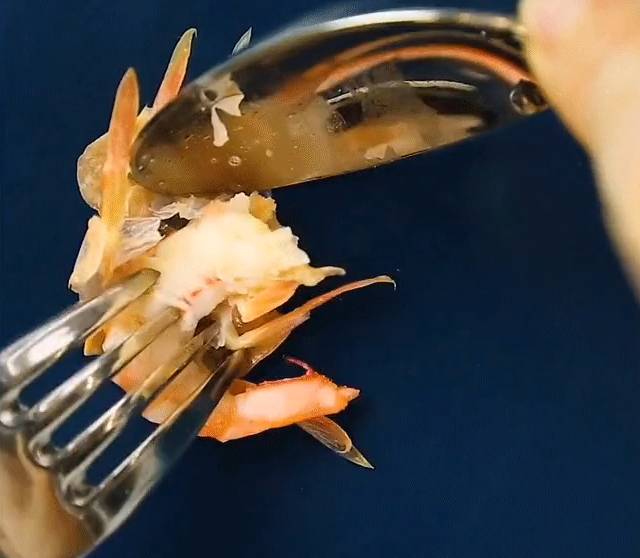
Slide the spoon under the shrimp’s abdomen to flip the shell upside down. Illustrated image by 5 Minute – Crafts
Continue to place the spoon under the shrimp’s abdomen and flip the shell upside down to separate the shell. When separating the last shell joint (the tail joint), hold the shrimp’s tail firmly with the spoon. Then use the fork to skewer the shrimp’s meat and pull it out forcefully – the shrimp is peeled.

Peeling shrimp with a spoon and fork. Illustrated image.
Alternatively, after separating the head and body of the shrimp, count three notches upwards from the shrimp’s tail, place the fork in that position to secure the shrimp’s body, then use the spoon to slide between the shell and the shrimp’s legs to flip and peel the shrimp shell upside down.
Peel skewered shrimp with chopsticks
For skewered grilled shrimp, use chopsticks to peel the shrimp.
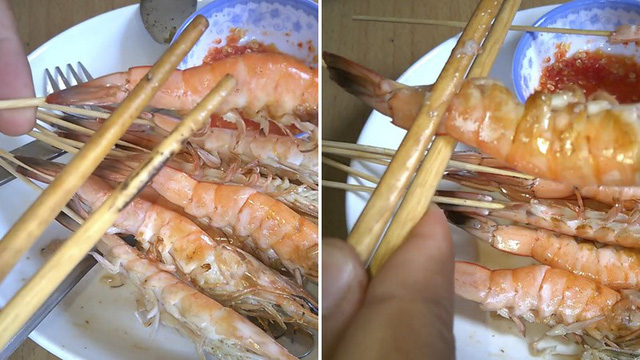
Peel skewered shrimp using chopsticks. Illustrated image.
– Hold the shrimp skewer firmly, hold a pair of chopsticks tightly on the shrimp’s tail, and gently pull it back a few times to separate the tail from the skewer.
Now hold the skewer and use the chopsticks to grip the middle of the shrimp’s body, gently pull the chopsticks forward a few times to separate the shell and head of the shrimp from the body.
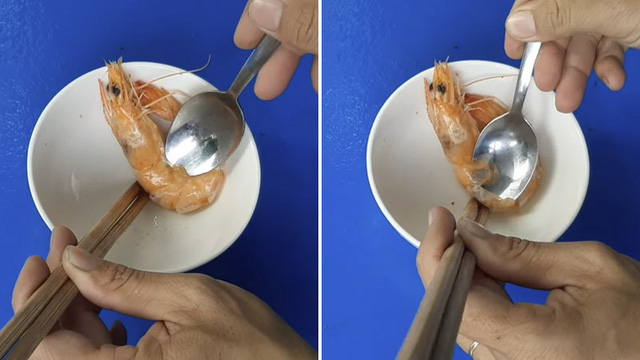
Peel shrimp with a spoon and chopsticks. Internet image.
Peel deep-fried shrimp with a spoon and chopsticks
If you don’t have a fork, you can use chopsticks to peel shrimp.
First, grab the shrimp in a bowl, use a pair of chopsticks to secure the shrimp. Slide the spoon under the shrimp’s abdomen and flip it upside down to separate the shrimp’s shell.
Then switch back to using the spoon to secure the shrimp’s tail, use the chopsticks to grip and pull out the shrimp’s meat to enjoy the shrimp dish.
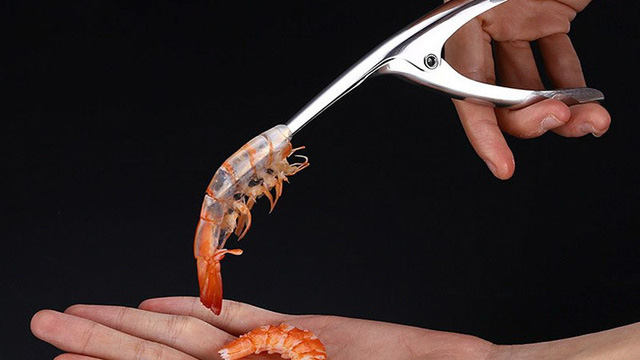
Peel shrimp with a specialized shell-peeling tool. Illustrated image.
Peel shrimp at home
At home, in a place where no one pays attention, you can use your hands to peel shrimp quickly and save time.
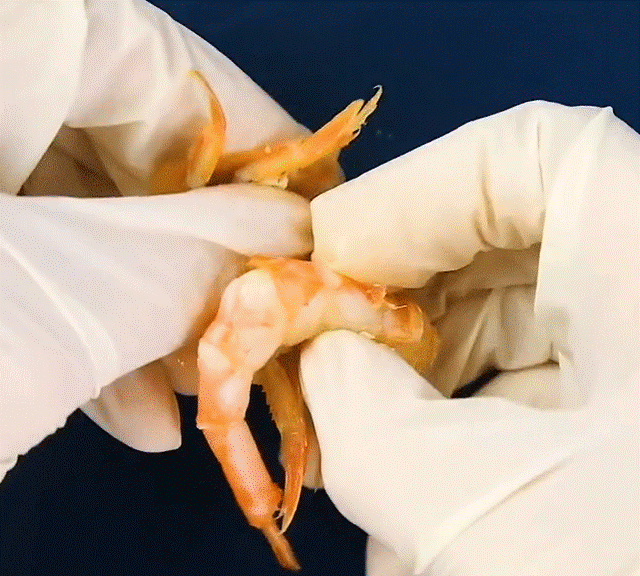
Simple shrimp peeling at home.
Separate the shrimp’s head from its body, count three shell notches upwards from the shrimp’s tail, then separate the tail shell at the third notch. Since the shrimp’s tail has been peeled, it’s easier to peel the shrimp’s head, so you can just peel the remaining head of the shrimp.
Peeling shrimp is not difficult, but you need to practice peeling with a spoon and fork at home to become proficient. You should keep this method of peeling shrimp with a spoon and fork – especially women – as it will be very helpful when attending parties with shrimp dishes, allowing you to comfortably enjoy shrimp without worrying about dirty hands.
When attending banquets or parties, the following people should still avoid eating shrimp:
Shrimp is very nutritious, with a high nutritional value, rich in protein, carbohydrates, calcium, phosphorus, potassium… The fat content in shrimp is very low compared to other seafood, so those who want to supplement nutrients without worrying about gaining weight should eat shrimp.
However, shrimp is not suitable for everyone, and the following people need to limit or avoid eating shrimp when their health is not normal:
– People with red eyes, hyperthyroidism will have worsened symptoms when eating shrimp.
– People with high cholesterol levels, high blood fat, or a history of cardiovascular diseases, with inflammatory symptoms, should not eat too much shrimp as it may worsen the inflammation.
– People with seafood allergies should avoid eating shrimp as they may have an allergic reaction.
– People with weak stomachs (easily have diarrhea or sensitive stomach and intestines to seafood) should limit their consumption of shrimp as it may cause abdominal pain and diarrhea.
– People with gout, increased uric acid, joint inflammation should not eat too much shrimp as it can lead to the accumulation of uric acid crystals in the joints, making the condition worse.
– Children should remove the shell completely when eating shrimp to avoid it getting stuck in their throat, causing itching and coughing.
– People with coughs, asthma should avoid eating shrimp with shells.
According to Giadinh.net
How to Choose Fresh Seafood: Important Cabinet Tips
In recent years, concerns have been raised over the practice of injecting urea and chemicals into seafood, making it difficult to find safe and fresh options. To help, DienmayXANH.com offers some tips on how to select the best seafood available. Seafood is a rich, delicious, and nutritious source of food, and this advice will help ensure you make the most of it.

























